 Thanks: 0
Thanks: 0
 Likes: 0
Likes: 0
 Needs Pictures: 0
Needs Pictures: 0
 Picture(s) thanks: 0
Picture(s) thanks: 0
Results 1 to 7 of 7
-
19th August 2007, 04:48 AM #1
 The Lie Nielsen Face Joinery Float - Reviewed
The Lie Nielsen Face Joinery Float - Reviewed
The Lie Nielsen Face Joinery Float - Reviewed
Very recently Lie Nielsen released a set of joinery floats that were fashioned after the planemaker’s floats they were producing in association with Clark & Williams. These floats are intended to aid in the fine-tuning of joints used in cabinetmaking. There are three floats in all, two for mortices and one for tenons. The float under review is the Face Float for tuning tenons.
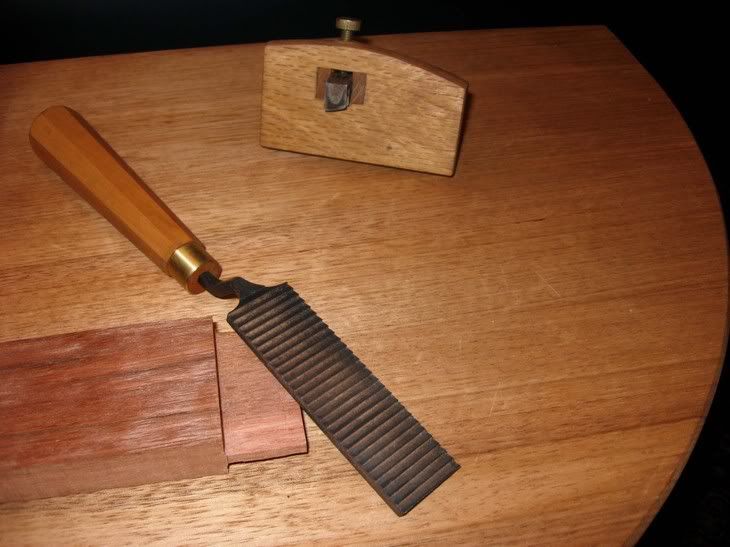
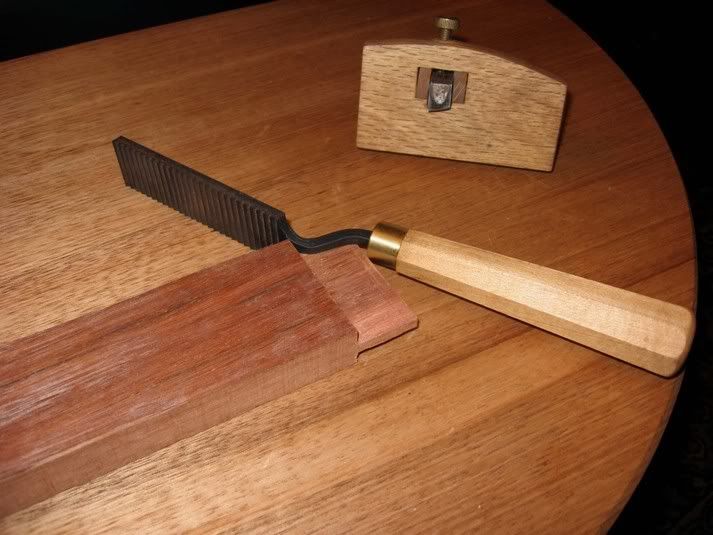
Construction and Dimensions
The face float is available in a push or pull version. I purchased the push version because I found this to be the more natural action.
According to the LN website, these are made from S-7 tool steel, hardened and tempered to RC 50-52 for edge life and resharpening ability. 8tpi, 80° rake angle, maple handles. It is 1” wide and 3 3/8” long.
Preparation
While the floats come sharpened and may be used straight out of the box, it is recommended that the teeth be first filed. I will reinforce this recommendation as I did initially use the float without filing the teeth, and was disappointed in the performance.
To illustrate the difference, I did a test with half the teeth filed and the other half original. Here is the result:
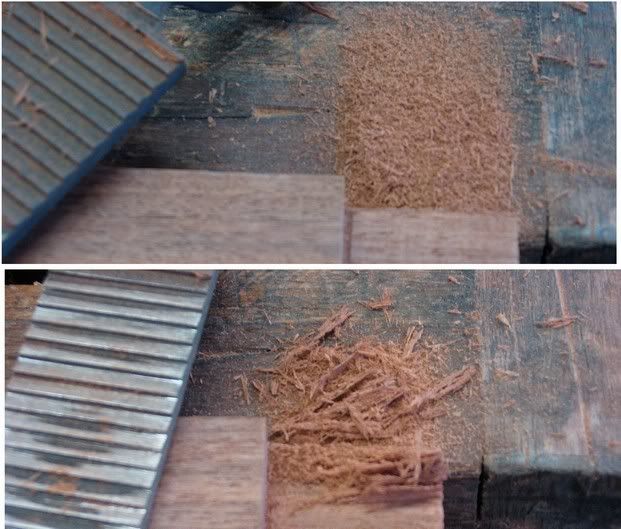
Top unfiled, bottom filed.
Filing the teeth
LN suggests a 6 inch double extra slim taper file for sharpening. I did not have one to hand, so first tried with a 4 inch double slim taper Groblet, a file I use for sharpening a 15 tpi dovetail saw. This proved to work exceedingly slowly, and so I turned to a 6” extra slim Nicholson file. This ended up being a good choice.
Finally I found a use for my Zyliss vise! It made a good support for filing the float.
From the LN website ….
Initial sharpening: The black oxide coating of the floats is an aid in the initial sharpening. Simply file away the black coating to shiny metal for the first sharpening. Use care to apply a slight even pressure on the file to maintain the cutting geometry. On wider sections you may notice some very slight distortion showing as slightly low spots on the faces of the teeth. This is normal and is the result of volumetric changes and stresses of heat treating. It’s not necessary to remove the hollow, establishing a good cutting edge on the teeth is the goal.
The full instructions may be found on the LN website.
Below I am supporting the file flat on the face and against the gullet.
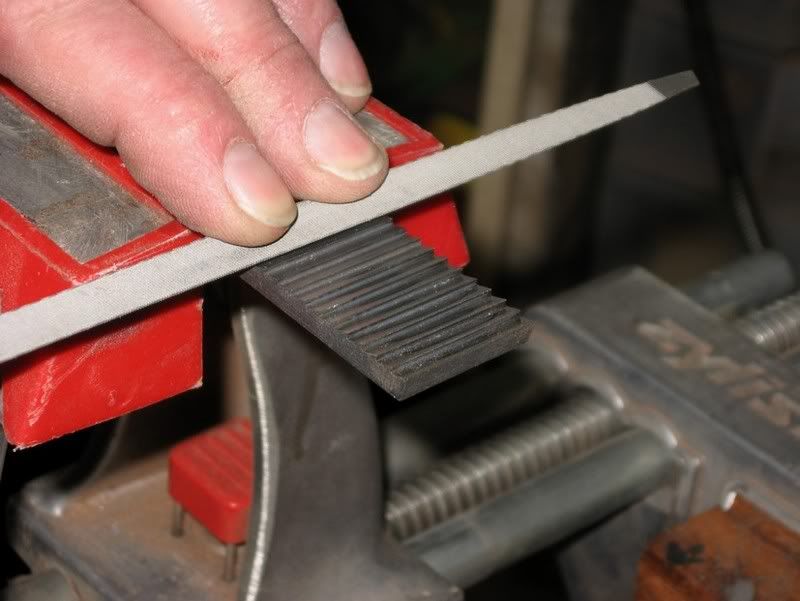
Here is the half-original, half-sharpened result. Note the hollows in some of the faces.
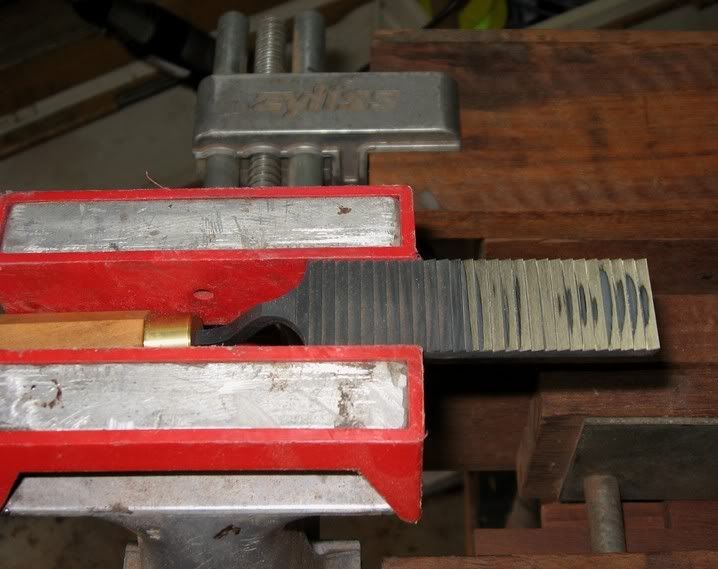
The LN face float is well made. Perhaps the only criticism is the need to sharpen it before it can be used. On the other hand, this will need to be done at some time anyway - not as often as a plane blade, but more much frequently than a handsaw. The initial filing was a relatively straight forward affair, and time will tell whether this is a task that remains so.
Cutting and Tuning Tenons
I generally cut tenons with either a backsaw or a bandsaw. For this assessment, I prepared a few in both Jarrah (representing hardwood) and construction Pine (representing softwood).
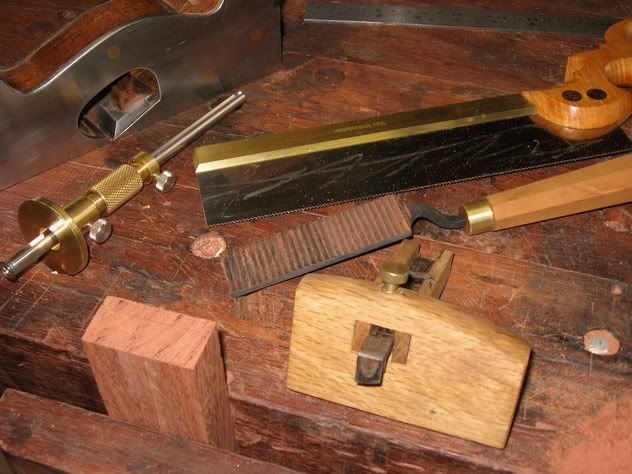
The plan is to compare tuning tenon faces using the joinery float, a rasp and a block plane.
The Joinery Float
The float is capable of removing a lot of waste very rapidly when used on hardwood. Before I sharpened the teeth, it had a feel more of a file, producing more dust than shavings. Once sharpened, the teeth could be felt biting into the wood.

I liked the control that the float gave. It was stable in use and left a flat, smooth finish to the tenon face.
Using the float on Pine was a less satisfactory story. Cutting across the grain now produced fine shavings and sawdust.
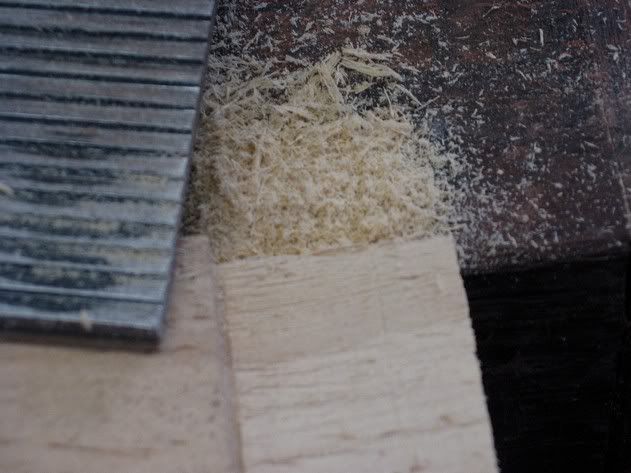 Visit www.inthewoodshop.com for tutorials on constructing handtools, handtool reviews, and my trials and tribulations with furniture builds.
Visit www.inthewoodshop.com for tutorials on constructing handtools, handtool reviews, and my trials and tribulations with furniture builds.
-
19th August 2007 04:48 AM # ADSGoogle Adsense Advertisement
- Join Date
- Always
- Location
- Advertising world
- Posts
- Many
-
19th August 2007, 04:49 AM #2

The Rasp
I used an Auriou AU-8-250-6, which is close in grain size to a Nicholson #49. In other words, it is quite a coarse rasp.
The Auriou cut fast, leaving a marked but acceptable smooth face.
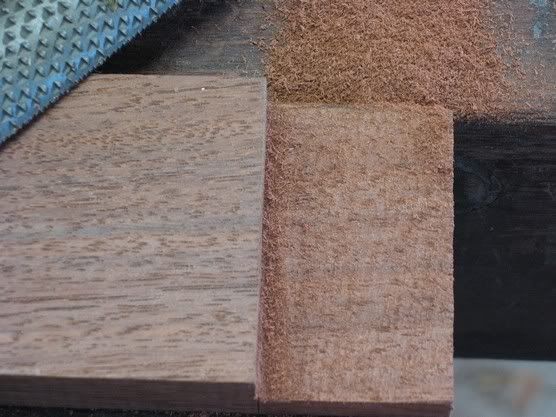
I like the rasp for use here, but I warn that use of one must be done with care. Its length makes it easy to tilt, and then it will create an off square face.
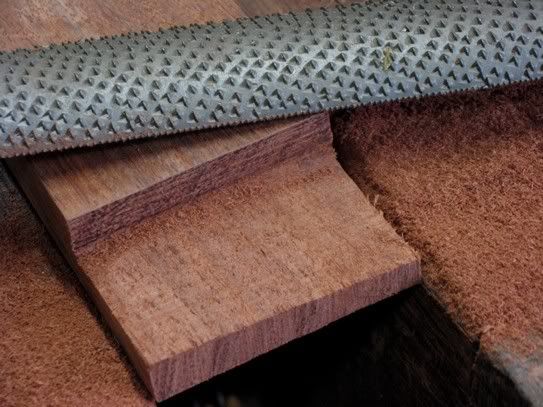
The performance of the rasp on soft Pine was very similar to that on hardwood.

The Block Plane
The handplane of choice for tuning tenon faces is the Stanley or LN #140, a skew block plane.
Here is my Stanley #140.
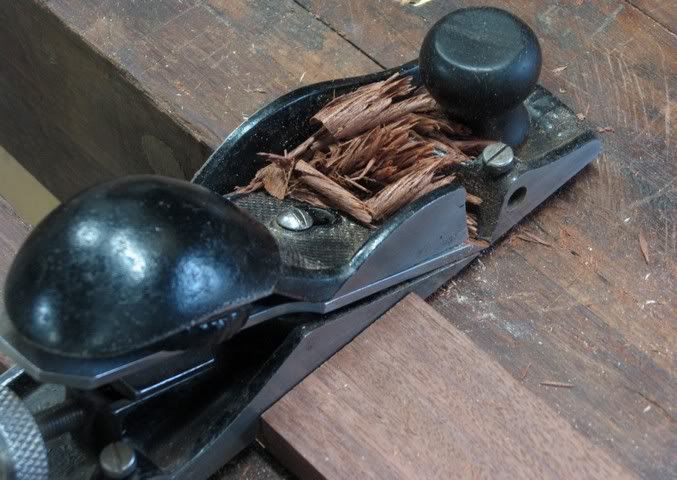

The #140 works equally well on hard- and softwood. It can remove a larger amount of waste quickly, which is, I believe, its advantage over the other tools here. It also produces the smoothest surface finish. However, like the rasp, care must be taken to keep the plane square.
Conclusions
When cutting tenons, I try to cut as close to the line as possible. Consequently, any tuning that needs to be done is usually a whisker here-or-there. A skew block plane gets the job done, but is sometimes like using a hammer to swat a fly. This is where the face float comes into its own. I liked the control it presented when removing waste. It could remove a little or a lot. The rasp is a possible alternative to the float, but it must be used with care. The bottom line is that a face float is a desirable tool for tuning tenons.
Derek Cohen
Perth, Australia
August 2007Visit www.inthewoodshop.com for tutorials on constructing handtools, handtool reviews, and my trials and tribulations with furniture builds.
-
19th August 2007, 09:56 AM #3

Good one Derek was an interesting read that. I have skew planes for tuning tenons but as you say easy to get out of control with them.
StudleyAussie Hardwood Number One
-
19th August 2007, 09:57 AM #4

Never seen one of those before. Interesting. Thankyou for all that.
I use my 140 at home. or a 289. whatevers sharp. at work I pinch the bosses 10, which can tear out a bit, but doesn't affect things much.
One concern with the float I'm having is the width. tenons are often wider than 1". plane blades are wider so the entire tenon width is reduced with one shaving....imagine you'd have to scrub a bit with the float. And I couldn't see why one would have to remove much from a tennon anyway. for me, normally I'm at most a mil oversize. That won't take long with a plane to creep a fit.
But I'd imagine there'd be a use for it eh. wonder if there's ever been a float version with teeth ascew to reduce tearout on the trailing edge of the pass. probably not. anyway. insteresting tool.
-
19th August 2007, 10:22 AM #5

As always a fascinating review, Derek.
Not sure that it will replace my existing combo of #140 (I'm not as brave as you when cutting with the saw, so my tenons often need a bit of hogging with the skew plane) and wide rasp (Dad left me a 2 1/2" wide rasp that means that you can keep a very flat face on the tenon).
Your comment on future sharpening without the guidance of the black finish made me think that if it is an issue, you could paint the face of the float with marking blue first. Since buying one litre of marking blue from RS Components, I have found heaps of uses for it in addition to marking out - I use it to help with any flattening task - plane soles, chisel blades, plane cutters.Cheers
Jeremy
If it were done when 'tis done, then 'twere well it were done quickly
-
19th August 2007, 11:22 AM #6
 Senior Member
Senior Member











- Join Date
- Oct 2003
- Location
- Perth
- Posts
- 158

Hello Derek
Thank you for the review and the very informative pictures. It is not possible to draw a word picture which conveys nearly as well as the photographs the difference between the shavings and finish.
I do wonder however that for a simple tool like this, which retails at over $90, a maker lie Lie Nielsen with a good high-end reputation does not provide a tool which is sharp enough to cut properly right out of the box.
RegardsPete J
-
19th August 2007, 08:44 PM #7

Hi Derek,
Yet another great review, as always. Thanks for posting.
Usually use a coarse file myself, with the same troublesome results you mention.
I actually saw at the car boot markets last year a set, (read several) of funny looking rasps on sale for next to nothing. I did not know the purpose of them so left them. Later learned that they were wooden plane makers tools. Oops ! What a find I let slip. Never mind.
Oops ! What a find I let slip. Never mind.
Cheers
Pops
Similar Threads
-
Lie Nielsen Toolworks
By Pat in forum Links to: WEB SITESReplies: 17Last Post: 8th November 2005, 10:22 AM -
Lie Nielsen Australia
By WRB in forum HAND TOOLS - UNPOWEREDReplies: 30Last Post: 22nd September 2005, 10:14 AM -
Lie Nielsen Chisels
By Wood Borer in forum HAND TOOLS - POWEREDReplies: 13Last Post: 22nd June 2005, 07:56 AM




 Reply With Quote
Reply With Quote
